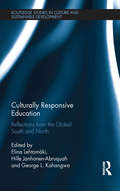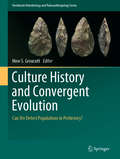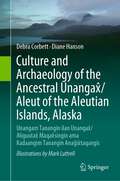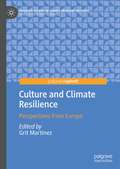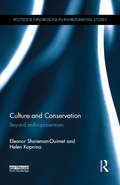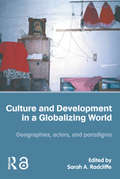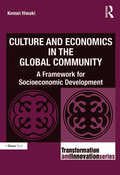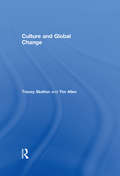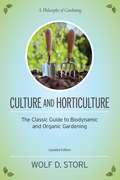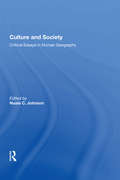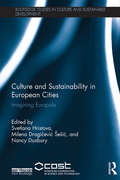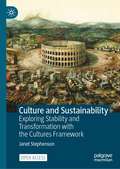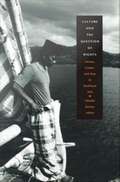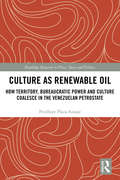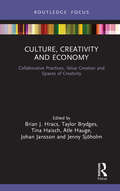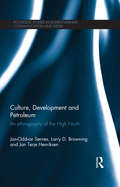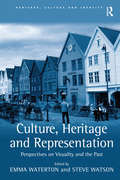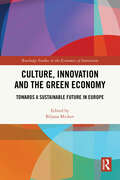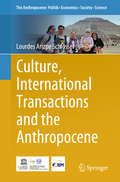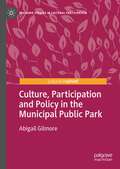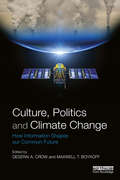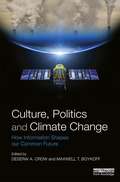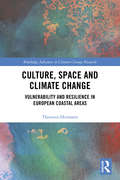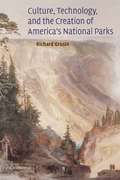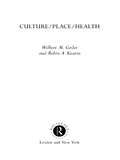- Table View
- List View
Culturally Responsive Education: Reflections from the Global South and North (Routledge Studies in Culture and Sustainable Development)
by Elina Lehtomäki Hille Janhonen-Abruquah George KahangwaCulturally Responsive Education: Reflections from the Global South and North examines culturally responsive education’s contribution to sustainable development and explores ways in which educational practitioners respond to cultures in and around educational contexts. This book argues that cultural responsiveness in education is invaluable for sustainability in and throughout education, and explores methods with which to deepen the understanding of the values and intercultural dialogue constantly present in education. Using a number of international and multidisciplinary studies, the authors offer a novel perspective on to the consideration of diversity throughout education and provide a valuable contribution to the ongoing global and national debate surrounding the UN Sustainable Development Goal initiative. With a focus on collaboration, this edited volume is vital reading for scholars, teachers and students of education, sociology, and development studies as well as education professionals. The book will also be of interest to education policy -makers and international and non-governmental organizations.
Culture History and Convergent Evolution: Can We Detect Populations in Prehistory? (Vertebrate Paleobiology and Paleoanthropology)
by Huw S. GroucuttThis volume brings together diverse contributions from leading archaeologists and paleoanthropologists, covering various spatial and temporal periods to distinguish convergent evolution from cultural transmission in order to see if we can discover ancient human populations. With a focus on lithic technology, the book analyzes ancient materials and cultures to systematically explore the theoretical and physical aspects of culture, convergence, and populations in human evolution and prehistory. The book will be of interest to academics, students and researchers in archaeology, paleoanthropology, genetics, and paleontology. The book begins by addressing early prehistory, discussing the convergent evolution of behaviors and the diverse ecological conditions driving the success of different evolutionary paths. Chapters discuss these topics and technology in the context of the Lower Paleolithic/Earlier Stone age and Middle Paleolithic/Middle Stone Age. The book then moves towards a focus on the prehistory of our species over the last 40,000 years. Topics covered include the human evolutionary and dispersal consequences of the Middle-Upper Paleolithic Transition in Western Eurasia. Readers will also learn about the cultural convergences, and divergences, that occurred during the Terminal Pleistocene and Holocene, such as the budding of human societies in the Americas. The book concludes by integrating these various perspectives and theories, and explores different methods of analysis to link technological developments and cultural convergence.
Culture and Archaeology of the Ancestral Unangax̂/Aleut of the Aleutian Islands, Alaska: Unangam Tanangin ilan Unangax̂/Aliguutax̂ Maqax̂singin ama Kadaangim Tanangin Anaĝix̂taqangis
by Debra Corbett Diane HansonFor the past 9,000 years, people lived and flourished along the 1,000-mile Aleutian archipelago reaching from the American continent nearly to Asia. The Aleutian chain and surrounding waters supported 40,000 or more people before the Russians arrived. Despite the antiquity of continuous human occupation, the size of the area, and the fascinating and complex social organization, the region has received scant notice from the public. This volume provides a thorough review describing the varied cultures of the ancestral Unangax̂, using archaeological reports, articles, and unpublished data; documented Unangax̂ oral histories, and ethnohistories from early European and American visitors, assessed through the authors’ multi-decade experience working in the Aleutian Archipelago.Unangam Tanangin ilan Unangax̂/Aliguutax̂ Maqax̂singin ama Kadaangim Tanangin Anaĝix̂taqangis (Culture and Archaeology of the Ancestral Unangax̂/Aleut of the Aleutian Islands, Alaska) begins with a description of the physical and biological world (The Physical Environment and The Living Environment) of which the Unangax̂ are part, followed by a description of the archaeological research in the region (The People). The rest of the book addresses ancestral Unangax̂ life including settlement on the land, and the characteristics of sites based on the activities that took place there (People on the Landscape). From this broad perspective, the view narrows to the people making a living through hunting, fishing, and collecting food along the shore-line, making their intricate tools, storing and cooking food, and sewing and weaving (Making a Living); household life including house construction, households, and the work done within the home (Life at Home); and the personal changes an individual goes through from the time they are born through death, including spiritual transitions and ceremonies (Transitions), and the evidence for these events in the material record. This book is written in gratitude to the Unangax̂ and Aleut people for the opportunity to work in Unangam Tanangin or the Aleutian Islands, and to learn about your culture. We hope you find this book useful. The purpose of this book is to introduce the broader public to the cultures of this North Pacific archipelago in a single source, while simultaneously providing researchers a comprehensive synthesis of archaeology in the region.
Culture and Climate Resilience: Perspectives from Europe (Palgrave Studies in Climate Resilient Societies)
by Grit MartinezThis book addresses the importance of cultural values, local knowledge and identity in building community resilience in place based contexts. There is a growing impetus among policy makers and practitioners to support and empower capacities of communities under changing climatic conditions. Despite this there is little systematic understanding of why approaches work at local levels or not and what makes some communities resilient and others less so. Europe is typically thought to be well equipped for coping with the effects of a changing climate - because of its moderate climate, its manifold urban-industrialized regions, it’s typically highly skilled population, its successes in science and technology and its advanced climate change policies. However, there is a growing need to understand the effects culture has on communal resiliency and for decision makers and planners to pay attention to historical and cultural characteristics and the complexity of contextualized local conditions to enable successful and durable implementation of climate change policies, programs and measures. This book will be a valuable resource for researchers, students, practitioners and policy makers interested in facilitating sustainable, resilient communities.
Culture and Conservation: Beyond Anthropocentrism (Routledge Explorations in Environmental Studies)
by Eleanor Shoreman-Ouimet Helen KopninaToday, there is growing interest in conservation and anthropologists have an important role to play in helping conservation succeed for the sake of humanity and for the sake of other species. Equally important, however, is the fact that we, as the species that causes extinctions, have a moral responsibility to those whose evolutionary unfolding and very future we threaten. This volume is an examination of the relationship between conservation and the social sciences, particularly anthropology. It calls for increased collaboration between anthropologists, conservationists and environmental scientists, and advocates for a shift towards an environmentally focused perspective that embraces not only cultural values and human rights, but also the intrinsic value and rights to life of nonhuman species. This book demonstrates that cultural and biological diversity are intimately interlinked, and equally threatened by the industrialism that endangers the planet's life-giving processes. The consideration of ecological data, as well as an expansion of ethics that embraces more than one species, is essential to a well-rounded understanding of the connections between human behavior and environmental wellbeing. This book gives students and researchers in anthropology, conservation, environmental ethics and across the social sciences an invaluable insight into how innovative and intensive new interdisciplinary approaches, questions, ethics and subject pools can close the gap between culture and conservation.
Culture and Development in a Globalizing World: Geographies, Actors and Paradigms
by Sarah A. RadcliffeUsing recent research on development projects around the world, this book argues that culture has become an explicit tool and framework for development discourse and practice. Providing a theoretical and empirically informed critique, this informative book includes conceptual overviews and case studies on topics such as: development for indigenous people natural resource management social capital and global markets for Third World music post-apartheid South Africa cultural difference in the USA’s late capitalism. The editor concludes by evaluating the outcomes of development’s ‘cultural turn’, proposing a framework for future work in this field. By combining case studies from both ‘Third World’ and ‘First World’ countries, the book, ideal for those in the fields of geography, culture and development studies, raises innovative questions about the ‘transferability’ of notions of culture across the world, and the types of actors involved.
Culture and Economics in the Global Community: A Framework for Socioeconomic Development (Transformation and Innovation)
by Kensei HiwakiMany of the concepts, values and basic assumptions on which 'modern' economic and business theory is based do not translate into or convey the same meaning in non-European languages or non-Western cultures as they do in Western societies. This results in a mismatch between what Many of the concepts, values and basic assumptions on which 'modern' economic and business theory is based do not translate into or convey the same meaning in non-European languages or non-Western cultures as they do in Western societies. This results in a mismatch between what have now become global economic values and 'local' cultural ones. Kensei Hiwaki considers a new paradigm - that a sound culture is needed to underpin development, employment and trade, and an optimal development path. This concept is discussed against the background of the author's contention that his own Japanese society has succumbed to unsustainable modern tendencies leading to the antithesis of sustainable development and placing the society and economy in a 'credibility trap' into which it is predicted other countries, like China, might also fall. Professor Hiwaki presents a detailed theoretical framework for balanced socioeconomic development relevant to sustainable development of the global community, explaining the pivotal concepts on which it is based, as well as the institutional and practical implications of adopting the paradigm, including new approaches to taxation, employment, trade, multi-media communications, and global governance. Culture and Economics in the Global Community is a challenging but ultimately hopeful book that introduces new perspectives for leaders in the political arena, in business, in development agencies, and to researchers and others with a professional or academic interest in economics, trade, governance and environmental issues, social policy or cultural anthropology.
Culture and Global Change
by Tracey Skelton Tim AllenCulture and Global Change presents a comprehensive introduction to the cultural aspects of third world development. It contains 25 chapters from leading writers in the field who each explore a particular aspect of 'culture' and the significance and meaning of cultural issues for different people in throughout the contemporary world. With chapters dealing with the importance of 'Third World' cultures but also with changes in Russia, Japan, the USA and the UK, this book considers the relationship between culture and development within a truly global context.
Culture and Horticulture: The Classic Guide to Biodynamic and Organic Gardening
by Wolf D. Storl Larry BergerVarious studies have shown time and again that small organic farms and home gardens are capable of producing more food per acre with less fossil energy than large-scale commercial agricultural installations dependent on machines and toxic chemical fertilizers and pesticides. This classic book by Wolf D. Storl, a respected elder in the practice of permaculture, details how food is grown holistically and beautifully by traditional communities around the world, and shows how to apply their ancient wisdom to our own gardens.With interest in natural, sustainable, organic and local food at an all-time high, people are looking beyond their farmers markets and CSA cooperatives to hyperlocal ways of growing healthy, delicious produce in urban gardens and their own backyards. Culture and Horticulture details time-tested methods that are as effective today as they were hundreds of years ago. On the practical front, the book works as a manual for creating and maintaining a bountiful harvest. It explains how to build the soil to maintain fertility; how to produce compost; how to plant, sow, and tend the various fruit and vegetable plants; how to rotate crops and practice companion planting; how to set up a favorable microclimate; how to deal with so-called weeds and pests; how to harvest at the right time; and finally how to store vegetables and herbs. Special emphasis is given to the art and science of composting, the compost being the "heart" of any self-sufficient garden and a model for the cycle of life, death, and rebirth.At the same time the reader is introduced to the wider aspects of horticulture, to its historical, philosophical, and cosmological contexts and social relevance. Gardening is a cultural activity, shaped by peoples' thoughts, wishes, and needs as well as by their cultural traditions. The author, an anthropologist by profession who has investigated the gardening practices of indigenous people throughout the world and worked for many years on biodynamic farms and in his own food garden, will introduce the reader to Rudolf Steiner's vision of the garden as an organic unit, embedded in the context of terrestrial and cosmic forces. Storl explains the importance of cosmic rhythms (solar, lunar, and planetary), the role of biodynamic herbal preparations as "medicines" for the garden organism, and the so-called "etheric" and "astral" forces. The book presents a vision of the garden as seen through the eyes of "Goethean science," a magical place where alchemical transformations of material substances take place.
Culture and Society: Critical Essays in Human Geography
by Nuala C. JohnsonHuman geographers have been at the forefront of research that examines the relationships between space, culture and society. This volume contains twenty-one essays, published over the past thirty years, that are iconic instances of this investigative field. With a focus on four broad themes - landscape, identity, colonialism, nature - these essays represent some of the best and most innovative interventions that geographers have made on these topics. From the visual to the corporeal, from rural Ceylon to urban America and from the sixteenth century to the twenty-first, this volume brings together a set of theoretically sophisticated and empirically grounded works.
Culture and Sustainability in European Cities: Imagining Europolis (Routledge Studies in Culture and Sustainable Development)
by Svetlana Hristova Nancy Duxbury Milena Dragićević ŠešićEuropean cities are contributing to the development of a more sustainable urban system that is capable of coping with economic crises, ecological challenges and social disparities in different nation-states and regions throughout Europe. This book reveals in a pluralistic way how European cities are generating new approaches to their sustainable development, and the special contribution of culture to these processes. It addresses both a deficit of attention to small and medium-sized cities in the framework of European sustainable development, and an underestimation of the role of culture, artistic expression and creativity for integrated development of the city as a prerequisite to urban sustainability. On the basis of a broad collection of case studies throughout Europe, representing a variety of regionally specific cultural models of sustainable development, the book investigates how participative culture, community arts, and more generally, creativity of civic imagination are conducive to the goal of a sustainable future of small and medium-sized cities. This is an essential volume for researchers and postgraduate students in urban studies, cultural studies, cultural geography and urban sociology as well as for policymakers and practitioners wanting to understand the specificity of European cities as hubs of innovation, creativity and artistic industriousness.
Culture and Sustainability: Exploring Stability and Transformation with the Cultures Framework
by Janet StephensonThis Open access book brings a cultural lens, and a distinctive analytical framework, to the problem of transitioning to a sustainable, low-carbon future. The world faces a seemingly impossible hurdle – to radically alter long-established social, economic and technological systems in order to live within the biophysical limits of the globe, while ensuring a just and enduring transition. The overarching premise of this book is that this cannot be achieved without widespread cultural change. ‘We need a change in culture’ is often used rhetorically, but what does this really mean?Stephenson starts by exploring culture’s elusiveness, describing its divergent interpretations before identifying core features of culture that are common across most definitions. These characteristics form the core of the cultures framework, an extensively tested approach to studying the links between culture and sustainability outcomes. The framework makes culture an accessible concept which can be analytically applied to almost any sustainability problem. Using many examples from around the world, Stephenson illustrates how cultural stability, cultural flexibility and cultural transformation all have a part to play in the sustainability transition. She guides the reader in the use of the cultures framework for policy development and to underpin research undertaken by individuals or by multi-disciplinary teams.Clearly and engagingly written, Culture and Sustainability is essential reading for academics, students, policy makers and indeed anyone interested in a sustainable future.
Culture and the Question of Rights: Forests, Coasts, and Seas in Southeast Asia
by Charles ZernerThis collection of ethnographic and interpretive essays fundamentally alters the debate over indigenous land claims in Southeast Asia and beyond. Based on fieldwork conducted in Malaysia and Indonesia during the 1980s and 1990s, these studies explore new terrain at the intersection of environmental justice, nature conservation, cultural performance, and the politics of making and interpreting claims. Calling for radical redefinitions of development and ownership and for new understandings of the translation of culture and rights in politically dangerous contexts--natural resource frontiers--this volume links social injustice and the degradation of Southeast Asian environments. Charles Zerner and his colleagues show how geographical areas once viewed as wild and undeveloped are actually cultural artifacts shaped by complex interactions with human societies. Drawing on richly varied sources of evidence and interpretation--from trance dances, court proceedings, tree planting patterns, marine and forest rituals, erotic poems, and codifications of customary law, Culture and the Question of Rights reveals the ironies, complexities, and histories of contemporary communities' struggles to retain their gardens, forests, fishing territories, and graveyards. The contributors examine how these cultural activities work to both construct and to lay claim to nature. These essays open up new avenues for negotiating indigenous rights against a background of violence, proliferating markets, and global ideas of biodiversity and threatened habitat. Contributors. Jane Atkinson, Don Brenneis, Stephanie Fried, Nancy Peluso, Marina Roseman, Anna Tsing, Charles Zerner
Culture as Renewable Oil: How Territory, Bureaucratic Power and Culture Coalesce in the Venezuelan Petrostate (Routledge Research in Place, Space and Politics)
by Penélope Plaza AzuajeThis book unpacks the links between oil energy, state power, urban space and culture, by looking at the Petro-Socialist Venezuelan oil state. It challenges the disciplinary compartmentalisation of the analysis of the material and cultural effects of oil to demonstrate that within the Petrostate, Territory, Bureaucratic Power and Culture become indivisible. To this end, it examines how oil is a cultural resource, in addition to a natural resource, implying therefore that struggles over culture implicate oil, and struggles over oil implicate culture. This book develops a story about Venezuela as an oil state and the way it deploys its policies to instrumentalise culture and urban space by examining the way Petro-Socialism manifests in space, how it is imagined in speeches and how it is discursively constructed in adverts. The discussion reveals how a particular culture is privileged by the Venezuela state-owned oil company and its social and cultural branch. The book explores to what effect the state-owned oil company constructs a parallel notion of culture that becomes inextricable from land, akin to a mineral deposit, and tightly controlled by the Petrostate. The book will appeal to researchers who are interested in Resource Management, Environmental Studies, Cultural Studies and Political Geography.
Culture, Creativity and Economy: Collaborative Practices, Value Creation and Spaces of Creativity (The Dynamics of Economic Space)
by Brian J. Hracs Taylor Brydges Tina Haisch Atle Hauge Johan Jansson Jenny SjoholmThis book nuances our understanding of the contemporary creative economy by engaging with a set of three key tensions which emerged over the course of eight European Colloquiums on Culture, Creativity and Economy (CCE): 1) the tension between individual and collaborative creative practices, 2) the tension between tradition and innovation, and 3) the tension between isolated and interconnected spaces of creativity. Rather than focusing on specific processes, such as production, industries or locations, the tensions acknowledge and engage with the messy and restless nature of the creative economy. Individual chapters offer insights into poorly understood practices, locations and contexts such as co-working spaces in Berlin and rural Spain, creative businesses in Leicester and the role and importance of cultural intermediaries in creative economies within Africa. Others examine the nature of trans-local cultural flows, the evolving "field" of fashion, and the implications of social media and crowdfunding platforms. This book will be of interest to students, scholars and professionals researching the creative economy, as well as specific cultural and creative industries, across the humanities and social sciences.
Culture, Development and Petroleum: An Ethnography of the High North (Routledge Studies in Environmental Communication and Media)
by Jan-Oddvar Sornes Larry Browning Jan Terje HenriksenThe discovery, just forty years ago, of vast oil and gas reserves in the Southwestern part of Norway, and more recently in the Arctic High North region, created an economic titan and posed a vast array of challenges for both the Norwegian government and the residents of this area. How to extract and transport all that oil and gas without despoiling the pristine environment? How to use this wealth in a socially responsible and sustainable way? How to prepare the rural High North citizens—traditionally fishermen and farmers—for a global, high-tech economy? Adopting an original narrative approach to qualitative research, this book tells the stories of 21 individuals either living or having a genuine interest in the High North, from mayors and entrepreneurs to farmers and fishermen. Through these first-hand meetings, it constructs an ethnographic study that reveals how petroleum and development have impacted on the regional economy and culture. This book will be of interest to all stakeholders in the oil and gas industry, and for students and scholars of organization studies, cultural and communication studies, environmental anthropology, natural resource management and sustainable development.
Culture, Heritage and Representation: Perspectives on Visuality and the Past (Heritage, Culture and Identity)
by Steve WatsonThe 'visual' has long played a crucial role in forming experiences, associations, expectations and understandings of heritage. Images convey meaning within a range of practices, including tourism, identity construction, the popularization of the past through a variety of media, and the memorialization of events. However, despite the central role of 'the visual' in these contexts, it has been largely neglected in heritage literature. This edited collection is the first to explore the production, use and consumption of visual imagery as an integral part of heritage. Drawing on case studies from around the world, it provides a multidisciplinary analysis of heritage representations, combining complex understandings of the 'visual' from a wide range of disciplines, including heritage studies, sociology and cultural studies perspectives. In doing so, the book provides a comprehensive overview of the theoretical and methodological tools necessary for understanding visual imagery within its cultural context.
Culture, Innovation and the Green Economy: Towards a Sustainable Future in Europe (Routledge Studies in the Economics of Innovation)
by Biljana MickovThe book offers a theoretical and practical analysis of the contemporary approach to art, culture and innovation, with special emphasis on the relationship between culture, innovation and the economy, in the context of green transition, as an indispensable sustainability factor.It presents new models that can be implemented, especially within strategic cultural planning, serving to ensure future development and attain certain levels of stability. The book argues that the cultural ecosystem should not be treated as merely a segment of the economy, but rather as a system that contains the economy. One of the main issues covered in the book is climate change. More than fifty years have passed since the first major conference of the United Nations (UN) on the Environment held in Stockholm in 1972, which gave birth to the “Stockholm Declaration”, and also cemented the global environmental movement. Thanks to Agenda 2030, the 17 Sustainable Development Goals and the Paris Agreement, there is an increased awareness of the dangers posed by climate change and of the need to switch to sustainable energy sources and a circular economy in the hope of preventing environmental problems that threaten life on Earth. Each chapter provides an accessible bank of knowledge on which existing theory and practice can be developed and new projects undertaken.The book adopts a highly interdisciplinary approach for open science, bridging theoretical insights with practical applications, and offers a comprehensive perspective that is both informative and actionable, so it can be used by academics, researchers, policy makers and cultural professionals for planning and development within the cultural sector.Biljana Mickov is a cultural researcher and professor. She holds a PhD from University of Reims Champagne - Ardeen.
Culture, International Transactions and the Anthropocene: Culture And Heritage In A Cosmopolitan World (The Anthropocene: Politik—Economics—Society—Science #17)
by Lourdes Arizpe SchlosserThis book analyses how global transactions have been progressively conducted and negotiated in the last 25 years. Achieving a new understanding of sustainability transition in the Anthropocene requires a deeper analysis on culture. The development of new positions of international institutions, national governments, scientific organizations, private fora and civil society movements on culture and nature shows how global transactions must take place in a rapidly transforming world. In her book the author provides a multi-situated ethnography of live debates on culture, global environmental change, development and diversity directly recorded by the author as a participating and decision-making anthropologist from 1988 to 2016. She examines the politicization and internationalization of culture by recognizing, negotiating and diversifying views on cultures and re-thinking culture in the Anthropocene. The merging of science and policy in taking up cultural and natural challenges in the Anthropocene is discussed.
Culture, Participation and Policy in the Municipal Public Park (Palgrave Studies in Cultural Participation)
by Abigail GilmoreThis book concerns the values and practices of participation in municipal public parks, and the connections they have with cultural policy, urbanism, and social life. Adopting a critical cultural policy lens, it identifies the park as a mundane but extraordinarily treasured place for the production and exchange of cultural values, regulation, resistance, and the practising of citizenship. Drawing on extensive mixed-methods research on everyday participation in diverse local cultural ecosystems in England and Scotland, the book examines the social lives of parks and their users, and the important public values that are generated through their common stewardship and usership. It presents case studies of parks and co-located museums as cultural public spheres, which promote both commoning and commodification. These are contextualized by histories of municipal parkmaking from the nineteenth century to the present and related to the making of local government and to other civic and cultural institutions.The book highlights contemporary issues of austerity, marketisation and de-municipalisation within local government in the context of urban development. It positions the public park as fundamental to democratic cultural governance and makes the case for the primacy of public trust, ownership, and park equity in safeguarding the right to the city.
Culture, Politics and Climate Change: How Information Shapes our Common Future
by Maxwell T. Boykoff Deserai A. CrowFocusing on cultural values and norms as they are translated into politics and policy outcomes, this book presents a unique contribution in combining research from varied disciplines and from both the developed and developing world. This collection draws from multiple perspectives to present an overview of the knowledge related to our current understanding of climate change politics and culture. It is divided into four sections – Culture and Values, Communication and Media, Politics and Policy, and Future Directions in Climate Politics Scholarship – each followed by a commentary from a key expert in the field. The book includes analysis of the challenges and opportunities for establishing successful communication on climate change among scientists, the media, policy-makers, and activists. With an emphasis on the interrelation between social, cultural, and political aspects of climate change communication, this volume should be of interest to students and scholars of climate change, environment studies, environmental policy, communication, cultural studies, media studies, politics, sociology.
Culture, Politics, and Climate Change: How Information Shapes our Common Future
by Maxwell T. Boykoff Deserai A. CrowFocusing on cultural values and norms as they are translated into politics and policy outcomes, this book presents a unique contribution in combining research from varied disciplines and from both the developed and developing world.<P> This collection draws from multiple perspectives to present an overview of the knowledge related to our current understanding of climate change politics and culture. It is divided into four sections – Culture and Values, Communication and Media, Politics and Policy, and Future Directions in Climate Politics Scholarship – each followed by a commentary from a key expert in the field. The book includes analysis of the challenges and opportunities for establishing successful communication on climate change among scientists, the media, policy-makers, and activists.<P> With an emphasis on the interrelation between social, cultural, and political aspects of climate change communication, this volume should be of interest to students and scholars of climate change, environment studies, environmental policy, communication, cultural studies, media studies, politics, sociology.
Culture, Space and Climate Change: Vulnerability and Resilience in European Coastal Areas (Routledge Advances in Climate Change Research)
by Thorsten HeimannWays of handling climate change vary worldwide. Differences can be observed in the perception of potential threats and opportunities as well as in the appraisal of adequate coping strategies. Collective efforts often fail not because of technical restrictions, but as a result of social and cultural differences between the actors involved. Consequently, there is a need to explore in greater depth those zones of cultural friction which emerge when actors deal with climate change. This book examines how cultural differences in the handling of climate change can be described and explained. The work develops the concept of culture as relational space, elaborates explanatory approaches, and investigates them by surveying more than 800 actors responsible for spatial development of the European coastal regions in the Netherlands, Germany, Denmark, and Poland. In doing so, this book engages with debates on cultural globalisation, in which the attachment of culture to place is increasingly being questioned. Adopting the approach of culture as relational space allows possible cultural formations to be examined across diverse fields of application from the local to the global scale. In addition, the book investigates how far different value orientations, beliefs, and identities can explain diverse perceptions of problems and opportunities right up to preferences for climate-mitigation and adaptation measures. Providing comprehensive insights into the diverse zones of cultural friction which scholars and practitioners face when handling climate change locally and globally, this book will be of great interest to those studying climate change, environmental sociology, and sustainable planning.
Culture, Technology, and the Creation of America's National Parks
by Richard GrusinRichard Grusin's innovative study investigates how the establishment of national parks participated in the production of American national identity after the Civil War. The creation of America's national parks is usually seen as an uncomplicated act of environmental preservation. Grusin argues, instead, that parks must be understood as complex cultural technologies for the reproduction of nature as landscape art. He explores the origins of America's three major parks--Yosemite, Yellowstone, and Grand Canyon--in relation to other forms of landscape representation including photography, mapping, travel writing, and fiction.
Culture/Place/Health (Critical Geographies #Vol. 16)
by Wilbert M. Gesler Robin A. KearnsCulture/Place/Health is the first exploration of cultural-geographical health research for a decade, drawing on contemporary research undertaken by geographers and other social scientists to explore the links between culture, place and health. It uses a wealth of examples from societies around the world to assert the place of culture in shaping relations between health and place. It contributes to an expanding of horizons at the intersection of the discipline of geography and the multidisciplinary domain of health concerns.
